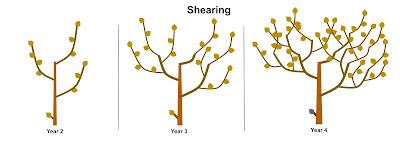How to Maintain Fruit Trees at the Same Height Year After Year
In the previous article, we defined the apical bud on a fruit tree branch. The apical bud is also referred to in this blog as the terminal bud. In addition to the apical bud, we discussed a hormone called Auxin. Auxin is responsible for preventing lateral buds from elongating and growing out of control. In this week's article we will discuss how to maintain fruit trees at the same height year after year.
In order fully understand this process it is important to understand what is the apical bud and how it affects the growth of your fruit trees. If you have not read the previous article, please follow this link.
Tipping your fruit tree is one of the eight steps to structural pruning found in our free online Fruit Tree Pruning Course and without it, your fruit trees will grow to an unmanageable size. Tipping your fruit trees is not the same as topping them! Shearing your tree like a hedge is also not the right solution.
Let's start at the beginning. When you tip a branch, you remove the apical bud, which removes the auxin producing part of that branch. This will cause the lateral buds at the end of the branch to elongate and compete for dominance. The new dominant branches will then grow past the pruning cut, as diagrammed below.
.jpg) |
| Click Image to Zoom |
If you cut all three or four new branches that extended past the pruning cut you will be "shearing" you tree. Each and every branch that you cut will again send out three or four new competing branches. It won't take long before your tree becomes a round ball of dense growth, but the growth will be at the outer ends of the tree. This mass of growth will shade the rest of the tree and cause inner branches to die or become infested with disease.
 |
| Click Image to Zoom |
Sometimes gardeners will prune their trees without knowing that they are slowly shearing them year after year and before they know it, they recognize that their tree needs a reset. At this point they will top their tree to remove the dense mass of branches at the tips. This too will cause irreversible damage to your trees. Topping you trees will cause them to die back to the nearest bud and the stubs will attract pests and rot away before they can be sealed off.
What is the Difference Between Tipping and Topping?
Now that you understand how fruit trees respond to pruning, how they can quickly get out of control and why it's important not to top your trees, let's talk about thinning and tipping.
If you are enjoying this article and would like to receive regular updates, Please subscribe here:
Rather than just focusing your pruning efforts on the tips, it is important to thin out branches below last year's pruning cut and then tip the remaining branch. Watch the following video to see how this is done.
 |
| Click Image to Zoom |
Thanks for reading! If you would like to learn more about the care and pruning of fruit trees, please browse our 100+ fruit tree articles here, join our Hobby Fruit Growers Facebook Group, and take our free Fruit Tree Pruning Course. Also, please subscribe to our Fruit Pruning YouTube Channel.








Comments
Post a Comment